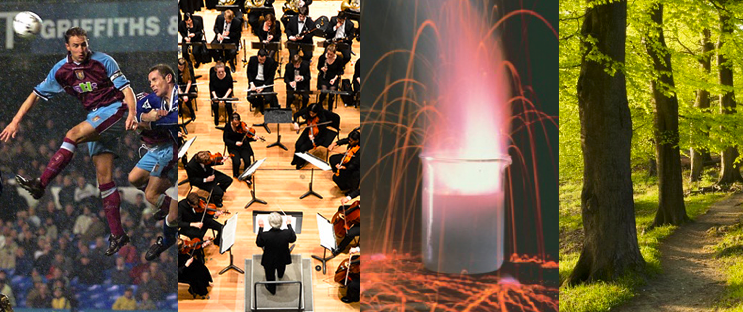
A vein of gypsum formed during the Permian Period about 260 million years ago. [o]
The history of life is not a continuum of development, but a record punctuated by brief, sometimes geologically instantaneous episodes of mass extinction and subsequent diversification. — Stephen Jay Gould 1
About midway through a course entitled Literature of the Anthropocene, the weight of loss threatens to crush some of my students. They’ve talked occasionally about kinds of action they might take against the tide of destruction we’ve confronted, but today that’s not enough to lift a sense of doom. It’s all those dead bats.
I want to help. I don’t want them to leave this course believing they’d be better off not attending to the ecocide underway. So I try something new; I ask them to think about the future in light of what we’ve learned about Earth’s deep life history: “Is there any consolation to be found in the fact that life does recover — that even after terrific losses in numbers of species and individual organisms, life bounces back? A mere 100,000 years after the end-Permian, life on earth had rebounded in abundance and diversity.” Some eye me warily, seeming to wonder if I could actually be serious.
Peter answers first. “No. I can’t feel on that timescale. I have to have hope for interventions that work on a schedule that makes sense to a human being.” He’s the same man who will encourage a classmate — who was electrified by chapters on ocean acidification in Elizabeth Kolbert’s The Sixth Extinction and wanted to do something to stop it — by saying: “Find a local effort, maybe sustainable food production in Lancaster County or fossil fuel divestment on campus. Something manageable. And devote your energies to that.”
I am a very small part of a big universe, says Peter, and that is okay. Small parts make up the total . . .
Then Jeremy Jackson, noted marine ecologist and paleontologist, comes to the college to give a lecture with the splashy title, “Ocean Apocalypse.” Jackson’s inventory of powerful stressors on Earth’s oceans — from overfishing to reef blasting, deadly pollution, vast gyres of endocrine-disrupting plastic, current-shifting temperature changes and acidification — shakes even Peter. In his response to the lecture, he writes, “I spent the rest of the day drifting around, thinking, sunk into a sad state. I still do not know what to think of the grim future.”
I know how he feels.
Yet by the end of the few paragraphs of his response Peter manages to write his way out of the Cave of Despond. Invoking the wisdom of child protagonist, Hushpuppy, from Beasts of the Southern Wild, he muses, “I am a very small part of a big universe, and that is okay. Small parts make up the total . . . maybe with cooperation, kindness, and hard work we can patch up the whole.”
So Peter, my sensitive student who claims smallness and continues to dig deeply for answers to the crises he sees advancing before him, is also doing things locally: organizing with other students to implement a composting program in the campus dining-hall and pressing the administration to divest from fossil fuels. At the same time, he tells me, he now thinks often of the deep past and future, and he finds some solace there.

The fossils found in the Burgess Shale include the 500-million-year-old ancestors of most modern animals. [o]
Dire times call for radical temporal recalibration. That is, how might we reframe the conversation about Time? The Anthropocene demands — or perhaps enables — this dwelling at once on at least two (multi-layered) temporal scales: 1) the temporality of a human lifetime, made up of various sub-temporalities (a childhood, a campaign, a bus ride, an undergraduate career, a pregnancy, a beloved dog, a summer, a clematis vine, a friendship) with the opportunities for action and meaning-making these human time-scales afford; and, 2) the deep timescale that can conceive a planetary history stretching long before and well beyond homo sapiens and the other creatures whose world we share in this moment, a vast temporality with lived sub-temporalities visible in rocky traces: “the Burgess shale, the Devonian Husrückschiefer of Germany, and the Carboniferous Mazon Creek near Chicago,”2 for instance.
David Wood’s notion of “time shelters” might be useful here. In his book, Time After Time (2007), Wood engages with Kierkegaard, Nietzsche, Heidegger, and Derrida, and accepts, without pessimism, the broad postmodern idea of the end of time. In doing so he exposes the rich, stratified, and non-linear textures of temporal complexity that characterize our world.

"Shelters": from football matches to musical performances, from chemical reactions to trees.
A time shelter, as he conceives it, is an “economy” of temporal organization. In an entropic universe, living beings “are essentially negentropic”: resisting disorder and creating order “whether at the molecular level or that of information”, or that of a tidy room.3 Each organization comprises a time shelter.
Once upon a time in the West, Wood argues, Time seemed singular, stable, flowing on with singular purpose. Once the grand narratives of “progress, emancipation, equality and justice” fail us, as Wood thinks they have, the multiplicity of time shelters becomes evident.4 The trusty river of Time now appears fractured into temporal creeks, or, into an imagined “subterranean flow that threatens to wash away the foundations of the city, and indeed, of nature.”5 He goes on: “Most of the ‘things’ we see around us are shelters . . . from football matches to musical performances, from chemical reactions to trees, from states to universities.”6 And each shelter entails a distinct temporality.
Wood thinks that this fragmented nature of time creates opportunities, and chief among them are the crossing of boundaries between time shelters. Such crossing, he suggests, generates a salutary space of discontinuity, thereby fostering “the growth of more luxuriant forms of spatial and temporal organization.” For Wood, such crossing has ethical implications, enhancing “the understanding of the fragility and vulnerability of all beings.”7 I think the Anthropocene can enable us to cultivate a sensitivity to the distinct and various temporalities of things: the young crab apple tree that put forth flowers for the first time this year, the sage brush that takes many long years to regenerate if disturbed, the grouse that depends on that sage for the coming mating season, the oil rigs recently planted amidst the sage.
If it doesn’t cure the world of human arrogance, it might soothe some sorrow as another species bites the dust.
Ah, there’s the rub. Wood writes of passing between disparate local time shelters, but doing so these days eventually leads to grief. Dwelling thoughtfully on fragile, vulnerable, present time shelters can be exhausting when so much is under threat or already lost.
I’m not suggesting we avoid grief. But passing between these more familiar, fragile, local shelters and also the more distant time shelters available to us primarily in the fossilized evidence in rock — and the fragile former worlds that rock reveals — might soften the shock of grief’s blows. We might say, “Just as those worlds passed, so will we and ours; others will emerge.” This passing between local and distant time shelters affords another order of “shelter.” Wood borrows the term shelter from economics, but it invokes for the reader other connotations of the term: refuge, sanctuary. Crossing into wildly foreign time shelters provides a livable alternative to the Cave of Despond in the age of ecocide. Peter eventually found this to be true.
Mind you, dwelling on vast geo-biospheric timescales could excuse complacency, even irresponsibility: “Since life will recover, I can do what I want.” But for my part, as for Peter, despair poses far greater danger than complacency, and remembering that life will recover can give heart, enabling continued action (writing letters, joining a blockade, landscaping for wildlife) in the face of dispiriting losses. If dwelling on deep history and the deep future doesn’t cure the world of human arrogance, at the very least, it might soothe some sorrow as another species bites the dust. After all, apocalypse — which Wood thinks might be a mere inversion of the grand narrative of progress8 — appears shortsighted in the light cast by deep history, a light by which our eyes might yet be trained to see. ≈©
1. Stephen J. Gould, Wonderful Life (New York: Norton, 1989) 54.
2. Rare repositories of soft-bodied fauna fossils. Gould, Wonderful Life, 61.
3. Wood, David, Time after Time (Bloomington: University of Indiana Press, 2007) 26.
4. Wood, 9.
5. Ibid.
6. Wood, 27.
7. Wood, 37.
8. Wood, 9.

JUDITH C. MUELLER, Professor of English at Franklin & Marshall College in Lancaster, Pennsylvania, teaches courses in literature and environmental studies. She lives and writes in an edible forest near the Susquehanna River.

Add new comment